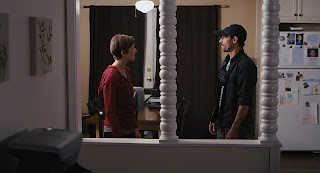Movie Review - Under the Silver Lake
From the way this film is shot, the tone at times and its direct references, it's not far-fetched to say that writer-director David Robert Mitchell's third feature could have been a modern-day Alfred Hitchcock film. Mitchell would then be positioning actor Andrew Garfield to be his James Stewart. Stewart made four films with Hitchcock. In addition to being impeccably directed, those four films featured intriguing plots anchored by men who had more going for them than Mitchell's protagonist. Mitchell's protagonist is suffering or experiencing a kind of ennui that makes him not engaging, particularly not engaging to the audience. He floats along not having to work and not seemingly wanting to work.
He then becomes obsessed with someone and something for no particular reason beyond superficial ones. Because there is no particular reason and because the protagonist has this ennui, it makes Mitchell's film drag. It certainly makes the film feel too long, mostly just spinning its wheels in a very lame mystery. With comedic elements sprinkled here, the lameness could itself be a kind of commentary on the film noir mysteries that Hitchcock crafted. Mitchell could be poking fun at Hitchcock in that regard. The film perhaps works as a spoof of the late British filmmaker. If so, this film could have used more jokes because as it stands now, the tone just doesn't support a spoof. If it wasn't trying to be a spoof, then this film could have used more import or seriousness toward whatever Mitchell's goal was.
Andrew Garfield (Hacksaw Ridge and The Social Network) stars as Sam, a twenty-something who lives in Silver Lake, a neighborhood in Los Angeles. Silver Lake is a gentrified area near downtown L. A., which is known for its LGBTQ population, as well as its hipster culture, expressed in its boutiques, coffee shops and indie music scene. Sam seems to spend the predominance of his time, going to said coffee shops during the day or parties of indie music bands at night. He's mostly though hanging out on the balcony of his apartment complex that faces an inner courtyard with a pool. On his balcony, he can sit and strum his guitar or use his binoculars to spy on his neighbors.
When we see Sam spying on his neighbors with those binoculars, one might immediately be reminded of when Stewart's character did the same in his second film with Hitchcock, that of Rear Window (1954). Stewart's character spied due to him being trapped in a wheelchair in his apartment and unable to do much of anything else. Here, Sam does so for prurient or lascivious reasons. One of his neighbors is a topless woman who frequently steps out onto her balcony with nothing covering her bare breasts.
Riley Keough (It Comes At Night and American Honey) co-stars as Sarah, another neighbor living in the same apartment building as Sam. The way she's photographed and viewed it's clear that she's the equivalent of the Hitchcock blonde. Even though she's not given as much to do, here she could also be the equivalent to Kim Novak's character in Vertigo (1958), the fourth and final film between Stewart and Hitchcock.
Sam becomes obsessed with Sarah, just as Stewart's character became obsessed with Novak's. Stewart and Novak's characters seemingly spend more time together before Stewart's character becomes obsessed. Sam and Sarah spend less than a day together. Stewart's character had a mental illness and his obsession was prompted by an extreme event that he himself had witnessed or thought he had witnessed. Sam presumably has no mental illness and his obsession isn't prompted by any extreme event.
Sarah disappears one day and Sam is told that she moved. It's not as if he suspects foul play or he's led to believe that something went wrong or something bad happened. After meeting her once and possibly having romantic designs on her, he sets out to try to find her, ignoring the fact that he's gotten an eviction notice and doesn't appear to have a job or any prospects of any income. Apparently, Mitchell doesn't want us to worry or take Sam's financial problems seriously because Sam sure doesn't. By the end, he'll just find someone to mooch off.
The main focus seems to be on the mystery, a mystery of subliminal messages and conspiracy theories. Sam follows a series of clues that takes him to various places around town. Each clue leads him to a person or situation that's supposed to be ominous or foreboding. Where it leads isn't to a place that matches that ominous or foreboding feeling. Where it leads is to a place that's just as masturbatory as the majority of the film.
Mitchell perhaps meant for the film to lead to a place that he sees as comical. His sense of humor here sways from meta-references like Sam's hand being stuck to a comic book of Spider-Man, which acknowledges Garfield's role in The Amazing Spider-Man (2012), to just outright grossness like a close-up shot of a toilet bowl filled with urine and large human feces. He also sways from slapstick, such as Sam getting sprayed by a skunk to an absurd moment of him popping up in a grocery store. There's moments of violence, but it's not clear if any of it can be taken with any consequence.
This movie just feels all over the place. A better modern-day film noir about a young man searching for a missing girl is Brick (2005). That film by Rian Johnson treated its film noir part with a bit more heft, if not a lot more than Mitchell does. Otherwise, this film just seems like an excuse for Mitchell to photograph various women either topless or scantily clad.
Rated R for strong sexual content, graphic nudity, violence, language and drug use.
Running Time: 2 hrs. and 19 mins.
Played in limited release and now available on VOD.
He then becomes obsessed with someone and something for no particular reason beyond superficial ones. Because there is no particular reason and because the protagonist has this ennui, it makes Mitchell's film drag. It certainly makes the film feel too long, mostly just spinning its wheels in a very lame mystery. With comedic elements sprinkled here, the lameness could itself be a kind of commentary on the film noir mysteries that Hitchcock crafted. Mitchell could be poking fun at Hitchcock in that regard. The film perhaps works as a spoof of the late British filmmaker. If so, this film could have used more jokes because as it stands now, the tone just doesn't support a spoof. If it wasn't trying to be a spoof, then this film could have used more import or seriousness toward whatever Mitchell's goal was.
Andrew Garfield (Hacksaw Ridge and The Social Network) stars as Sam, a twenty-something who lives in Silver Lake, a neighborhood in Los Angeles. Silver Lake is a gentrified area near downtown L. A., which is known for its LGBTQ population, as well as its hipster culture, expressed in its boutiques, coffee shops and indie music scene. Sam seems to spend the predominance of his time, going to said coffee shops during the day or parties of indie music bands at night. He's mostly though hanging out on the balcony of his apartment complex that faces an inner courtyard with a pool. On his balcony, he can sit and strum his guitar or use his binoculars to spy on his neighbors.
When we see Sam spying on his neighbors with those binoculars, one might immediately be reminded of when Stewart's character did the same in his second film with Hitchcock, that of Rear Window (1954). Stewart's character spied due to him being trapped in a wheelchair in his apartment and unable to do much of anything else. Here, Sam does so for prurient or lascivious reasons. One of his neighbors is a topless woman who frequently steps out onto her balcony with nothing covering her bare breasts.
Riley Keough (It Comes At Night and American Honey) co-stars as Sarah, another neighbor living in the same apartment building as Sam. The way she's photographed and viewed it's clear that she's the equivalent of the Hitchcock blonde. Even though she's not given as much to do, here she could also be the equivalent to Kim Novak's character in Vertigo (1958), the fourth and final film between Stewart and Hitchcock.
Sam becomes obsessed with Sarah, just as Stewart's character became obsessed with Novak's. Stewart and Novak's characters seemingly spend more time together before Stewart's character becomes obsessed. Sam and Sarah spend less than a day together. Stewart's character had a mental illness and his obsession was prompted by an extreme event that he himself had witnessed or thought he had witnessed. Sam presumably has no mental illness and his obsession isn't prompted by any extreme event.
Sarah disappears one day and Sam is told that she moved. It's not as if he suspects foul play or he's led to believe that something went wrong or something bad happened. After meeting her once and possibly having romantic designs on her, he sets out to try to find her, ignoring the fact that he's gotten an eviction notice and doesn't appear to have a job or any prospects of any income. Apparently, Mitchell doesn't want us to worry or take Sam's financial problems seriously because Sam sure doesn't. By the end, he'll just find someone to mooch off.
The main focus seems to be on the mystery, a mystery of subliminal messages and conspiracy theories. Sam follows a series of clues that takes him to various places around town. Each clue leads him to a person or situation that's supposed to be ominous or foreboding. Where it leads isn't to a place that matches that ominous or foreboding feeling. Where it leads is to a place that's just as masturbatory as the majority of the film.
Mitchell perhaps meant for the film to lead to a place that he sees as comical. His sense of humor here sways from meta-references like Sam's hand being stuck to a comic book of Spider-Man, which acknowledges Garfield's role in The Amazing Spider-Man (2012), to just outright grossness like a close-up shot of a toilet bowl filled with urine and large human feces. He also sways from slapstick, such as Sam getting sprayed by a skunk to an absurd moment of him popping up in a grocery store. There's moments of violence, but it's not clear if any of it can be taken with any consequence.
This movie just feels all over the place. A better modern-day film noir about a young man searching for a missing girl is Brick (2005). That film by Rian Johnson treated its film noir part with a bit more heft, if not a lot more than Mitchell does. Otherwise, this film just seems like an excuse for Mitchell to photograph various women either topless or scantily clad.
Rated R for strong sexual content, graphic nudity, violence, language and drug use.
Running Time: 2 hrs. and 19 mins.
Played in limited release and now available on VOD.















Comments
Post a Comment